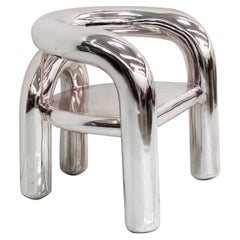Neotonic Chair
Recent Sales
2010s Modern Lounge Chairs
Resin
Jumbo Collection for sale on 1stDibs
Jumbo Collection reintroduced classic Italian style to a contemporary audience. The luxury furniture brand is known for its stunning Louis XVI-style furniture made from materials like solid wood and fine fabric upholstery. Its sophisticated pieces include exquisitely detailed sofas and armchairs, as well as ornate side tables. Each piece is crafted by hand according to traditional techniques.
Jumbo Collection was established in Cantù, Italy, in 1985. It builds on hundreds of years of Italian furniture-making and design. After just a few years in business, Jumbo Collection was selling its furniture in Russian, Middle Eastern and Asian markets. In the 1990s, the company introduced even more styles and designs, all made by hand in Italy and refined to meet its high standards.
The company positions itself as a brand for discerning buyers who value quality materials and aesthetic elegance. Jumbo Collection furniture is characterized by details like veneer inlays, intricate carvings and fine porcelain. Some of its pieces even feature semi-precious stones for an extra touch of luxury. Alongside this opulence, the furniture has modern clean and simple lines that allow these details to shine.
Jumbo Collection takes great pride in its Italian roots and manufacturing. It has received a 100% Made in Italy designation from the Institute for the Protection of Italian Manufacturers. The company is also part of Qualità Cantù 2001, a local association that promotes handmade Italian products abroad.
As reported by Interior Furniture Design Magazine, Jumbo Collection refocused on classicism and extreme luxury in 2022 as part of a more extensive rebranding operation. To support this effort, the company debuted its Interior Design Service, which is aimed at consumers, designers, studios and architects looking to collaborate on one-of-a-kind pieces.
On 1stDibs, find Jumbo Collection seating, tables, case pieces and more.
A Close Look at modern Furniture
The late 19th and early 20th centuries saw sweeping social change and major scientific advances — both of which contributed to a new aesthetic: modernism. Rejecting the rigidity of Victorian artistic conventions, modernists sought a new means of expression. References to the natural world and ornate classical embellishments gave way to the sleek simplicity of the Machine Age. Architect Philip Johnson characterized the hallmarks of modernism as “machine-like simplicity, smoothness or surface [and] avoidance of ornament.”
Early practitioners of modernist design include the De Stijl (“The Style”) group, founded in the Netherlands in 1917, and the Bauhaus School, founded two years later in Germany.
Followers of both groups produced sleek, spare designs — many of which became icons of daily life in the 20th century. The modernists rejected both natural and historical references and relied primarily on industrial materials such as metal, glass, plywood, and, later, plastics. While Bauhaus principals Marcel Breuer and Ludwig Mies van der Rohe created furniture from mass-produced, chrome-plated steel, American visionaries like Charles and Ray Eames worked in materials as novel as molded plywood and fiberglass. Today, Breuer’s Wassily chair, Mies van der Rohe’s Barcelona chair — crafted with his romantic partner, designer Lilly Reich — and the Eames lounge chair are emblems of progressive design and vintage originals are prized cornerstones of collections.
It’s difficult to overstate the influence that modernism continues to wield over designers and architects — and equally difficult to overstate how revolutionary it was when it first appeared a century ago. But because modernist furniture designs are so simple, they can blend in seamlessly with just about any type of décor. Don’t overlook them.
Finding the Right lounge-chairs for You
While this specific seating is known to all for its comfort and familiar form, the history of how your favorite antique or vintage lounge chair came to be is slightly more ambiguous.
Although there are rare armchairs dating back as far as the 17th century, some believe that the origins of the first official “lounge chair” are tied to Hungarian modernist designer-architect Marcel Breuer. Sure, Breuer wasn’t exactly reinventing the wheel when he introduced the Wassily lounge chair in 1925, but his seat was indeed revolutionary for its integration of bent tubular steel.
Officially, a lounge chair is simply defined as a “comfortable armchair,” which allows for the shape and material of the furnishings to be extremely diverse. Whether or not chaise longues make the cut for this category is a matter of frequent debate.
The Eames lounge chair, on the other hand, has come to define somewhat of a universal perception of what a lounge chair can be. Introduced in 1956, the Eames lounger (and its partner in cozy, the ottoman) quickly became staples in television shows, prestigious office buildings and sumptuous living rooms. Venerable American mid-century modern designers Charles and Ray Eames intended for it to be the peak of luxury, which they knew meant taking furniture to the next level of style and comfort. Their chair inspired many modern interpretations of the lounge — as well as numerous copies.
On 1stDibs, find a broad range of unique lounge chairs that includes everything from antique Victorian-era seating to vintage mid-century modern lounge chairs by craftspersons such as Hans Wegner to contemporary choices from today’s innovative designers.
